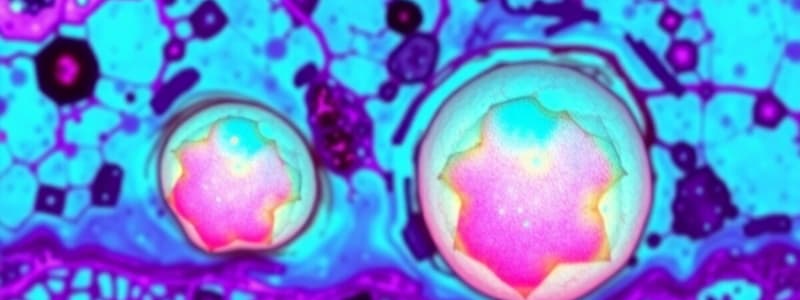Podcast
Questions and Answers
Which tumor is classified as a benign odontogenic tumor of mesenchymal origin?
Which tumor is classified as a benign odontogenic tumor of mesenchymal origin?
- Ameloblastoma
- Ghost Cell Odontogenic Carcinoma
- Odontogenic Myxoma (correct)
- Odontogenic Sarcoma
Which of the following tumors is associated with aggressive behavior in young patients?
Which of the following tumors is associated with aggressive behavior in young patients?
- Cementoblastoma
- Adenomatoid Odontogenic Tumor
- Juvenile Ossifying Fibroma (correct)
- Ameloblastoma
What is a key histological characteristic of clear cell odontogenic carcinoma?
What is a key histological characteristic of clear cell odontogenic carcinoma?
- Small round blue cells
- Presence of ghost cells
- Multinucleated giant cells
- Cells with clear cytoplasm (correct)
Which of the following is considered a malignant odontogenic tumor?
Which of the following is considered a malignant odontogenic tumor?
What is a main feature of odontogenic myxoma in terms of radiographic characteristics?
What is a main feature of odontogenic myxoma in terms of radiographic characteristics?
Which tumor is classified under tumors of debatable origin?
Which tumor is classified under tumors of debatable origin?
The histological appearance of which tumor includes abundant pigmented cells?
The histological appearance of which tumor includes abundant pigmented cells?
What distinguishes odontogenic carcinosarcoma from other odontogenic tumors?
What distinguishes odontogenic carcinosarcoma from other odontogenic tumors?
What is a characteristic feature of odontogenic fibroma?
What is a characteristic feature of odontogenic fibroma?
Which tumor has a similar origin to ameloblastoma but is classified as malignant?
Which tumor has a similar origin to ameloblastoma but is classified as malignant?
Flashcards
Ameloblastoma
Ameloblastoma
A type of benign odontogenic tumor originating from enamel-forming cells. It is characterized by a slow, painless growth and can occur in the jaw. It is often multilocular (having multiple compartments) and has a high recurrence rate.
Adenomatoid Odontogenic Tumor
Adenomatoid Odontogenic Tumor
A rare, benign tumor of the jaw that arises from the outer layer of the tooth germ. It is often found in the posterior mandible and has characteristic radiographic features of a well-defined, unilocular (single compartment), radiolucent lesion.
Ameloblastic Carcinoma
Ameloblastic Carcinoma
A malignant tumor that originates from the cells that form enamel. This fast-growing tumor can invade surrounding tissues and may metastasize to other parts of the body.
Juvenile Ossifying Fibroma
Juvenile Ossifying Fibroma
Signup and view all the flashcards
Odontogenic Myxoma
Odontogenic Myxoma
Signup and view all the flashcards
Odontogenic Carcinosarcoma
Odontogenic Carcinosarcoma
Signup and view all the flashcards
Compound Odontome
Compound Odontome
Signup and view all the flashcards
Calcifying Epithelial Odontogenic Tumor
Calcifying Epithelial Odontogenic Tumor
Signup and view all the flashcards
Primary Intraosseous Carcinoma
Primary Intraosseous Carcinoma
Signup and view all the flashcards
Clear Cell Odontogenic Carcinoma
Clear Cell Odontogenic Carcinoma
Signup and view all the flashcards
Study Notes
Odontogenic Tumors - Summary Notes
- Odontogenic tumors are derived from odontogenic tissues.
- Benign tumors are more common than malignant ones.
- Histologic examination is crucial for accurate diagnosis.
Benign Odontogenic Tumors
- Ameloblastoma: A common, often slowly expanding tumor with epithelial origin.
- Usually involves the jawbone.
- Radiographic appearance may be unilocular or multilocular.
- Compound/Complex Odontoma: A hamartoma of odontogenic tissue.
- Composed of various tooth structures (enamel, dentin, pulp).
- Typically radiopaque, appearing as multiple, small calcified masses.
- Cementoblastoma: A benign tumor of cementum.
- Commonly diagnosed in the 2nd or 3rd decade, more commonly in males.
- Radiolucent, usually with a well-defined border.
- Odontogenic Fibroma:
- Can be either central (within the bone) or peripheral (outside the bone).
- Radiographically usually appears radiolucent with well-defined borders.
- Odontogenic Myxoma:
- Rare, typically affecting younger patients.
- Involves the jaw bone.
- Can appear radiolucent.
- Calcifying Epithelial Odontogenic Tumor (CEOT):
- A relatively rare tumor with varying appearances.
Malignant Odontogenic Tumors
- Ameloblastic Carcinoma: A rare and aggressive tumor of epithelial origin.
- Has characteristics of malignancy : pleomorphism, hyperchromatism, increased mitotic activity
- Odontogenic Sarcomas: Rare malignant tumors of mesenchymal origin.
- Include fibrosarcomas.
Mixed Odontogenic Tumors
- Ameloblastic Fibroma (AF): A mixed tumor of epithelial and mesenchymal origin.
- Most commonly diagnosed in young adults (in their late teens).
- Typically painless, slow growing, radiolucent mass.
- Primordial Odontogenic Tumor (POT): Mixed type tumor.
- Similar to ameloblastic fibroma but has a different epithelial and mesenchymal origin.
- Often seen in teens.
Tumors of Debatable Origin
- Congenital Epulis (Congenital Gingival Granular Cell Tumor):
- Develops in newborns.
- Appears as a gingival swelling.
- Appears radiolucent.
- Melanotic Neuroectodermal Tumor of Infancy (MNET):
- Rare, occurs in newborns.
- Characterized by bluish/brown swelling in the anterior maxilla.
- Can resemble ameloblastoma on radiographs.
Diagnostic Considerations
- Careful history taking (age, gender, location, pain, etc.).
- Detailed physical examinations and radiographic studies are critical for proper diagnosis.
- Histologic evaluation is crucial to confirm the diagnosis.
Studying That Suits You
Use AI to generate personalized quizzes and flashcards to suit your learning preferences.




